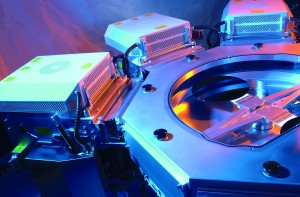Sep 18 2015
The University of Washington and Oregon State University have won a $4.5 million, five-year grant from the National Science Foundation to advance nanoscale science, engineering and technology research in the Pacific Northwest and support a new network of user sites across the country.
 The UW’s Washington Nanofabrication and Molecular Analysis Facilities house specialized equipment that will become part of a new national nanotechnology infrastructure network. Credit: University of Washington
The UW’s Washington Nanofabrication and Molecular Analysis Facilities house specialized equipment that will become part of a new national nanotechnology infrastructure network. Credit: University of Washington
The regional partnership was selected as one of 16 sites for a new National Nanotechnology Coordinated Infrastructure (NNCI) program. That network is designed to give researchers from academia, small and large companies and other institutions open access to university facilities with leading-edge fabrication and characterization tools.
Anchored at the UW with additional facilities at OSU, the Pacific Northwest site -- which will also leverage resources at Pacific Northwest National Laboratory, North Seattle College and the University of British Columbia -- will provide critical workhorse tools, unique instruments and key educational support to academic and industrial users, particularly in the clean energy and biotechnology fields.
At the UW, the funding will support the Washington Nanofabrication Facility and the Molecular Analysis Facility. The WNF makes chips with nanoscale-sized features and devices for UW researchers working on everything from better drug delivery to quantum information devices. The "fab lab" also serves outside companies -- ranging from one-person startups to multinational corporations -- that can't affordably or reliably meet their fabrication needs at commercial foundries.
Separately, the WNF will also undergo a $37 million renovation in Fluke Hall over the next year to expand its lab space and better serve those users.
The Molecular Analysis Facility, which opened in 2012, occupies a custom-designed space in the Molecular Engineering & Sciences building that minimizes vibration and electromagnetic interference. It houses a range of microscopy, spectroscopy and surface analysis instrumentation that characterize materials at the nano and molecular scale for applications ranging from biotechnology to clean energy technology.
The MAF employs a group of full-time staff scientists to help design, perform and troubleshoot experiments for users from the UW, other universities and industry.
The new NNCI funding will help support staff salaries, enabling them to expand "unpaid" work such as student mentoring. Current mentoring programs teach skills that are in high demand -- how to calibrate and operate tools used to develop cutting-edge electronics and technologies. The UW will also emphasize outreach to Native American students, one of the most underrepresented groups in science and tech fields.
"Part of our core mission is doing workforce development," said WNF associate director Michael Khbeis. "Most of the clients call me up and say 'I can't find anybody to do this kind of work who lives around here,' so we really try to share what we know to incubate that next generation of highly-skilled employees."
The NNCI funding will also free up staff to develop new lab technologies and train on new instruments before they're ready to serve clients, as well as allow time for basic research.
"We do a lot of training and mentoring and development that we don't bill clients for, so this funding will really take some of the burden off of the staff and help with these unpaid initiatives," Khbeis said.
The NSF grant will also fund new computational initiatives, allowing the labs to partner with data science experts across campus to more accurately model fabrication and nanoscale interactions.
Nationwide, the NSF will provide a total of $81 million in NNCI grants over the next five years. The framework builds on the National Nanotechnology Infrastructure Network, which enabled major discoveries, innovations, and contributions to education and commerce for more than 10 years.
"NSF's long-standing investments in nanotechnology infrastructure have helped the research community to make great progress by making research facilities available," said NSF assistant director for engineering Pramod Khargonekar. "NNCI will serve as a nationwide backbone for nanoscale research, which will lead to continuing innovations and economic and societal benefits."